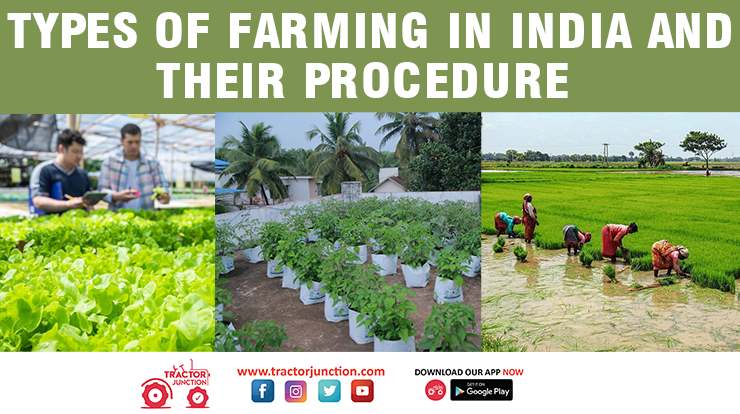Farming methods may change from place to place significantly depending on multiple factors -- can vary based on the local environment; technological advancements in a country, and overall cultural practices.
If you take the example of India, for instance, one would notice diverse farming systems. This would rely on agriculture types; specifically put: subsistence to commercial-style agriculture. Let’s have a look at them one by one and understand how it works in India for the farmers.
Primitive Subsistence Farming: This method is traditionally used and is also known as ‘slash and burn’ agriculture. In essence, the idea used by the farmers is to burn or clear a small area of land so that crops can be cultivated in that region -- can be cereals and various food staples. Interestingly, the cleared area is utilized until there comes a point wherein a decline in soil fertility is noticed -- so essentially this type of farming happens for a limited time.
Once the soil's productivity goes down significantly, farmers don’t have much choice -- their cultivation efforts have to be relocated to a new patch of fertile land.
Interestingly, as these farmers keep shifting (relocating from one section of land to another), they implement the same there -- repeating the process of clearing useful land and planting new crops.
This way they manage to sustain their livelihood through this tough farming practice -- a serious resilient sustenance or challenging agricultural task.
This approach which is labor-intensive in nature is known by different names across India; for example, it's called "jhumming" in the northeastern states.
Downsides of Primitive Subsistence Farming: Not only is this primitive style of farming difficult to carry out but it has its own set of limitations; explained hereunder.
To start with, this kind of practice tends to result in quite low productivity when comparison is drawn with more modern farming techniques.
Furthermore, the dependence of primitive subsistence farming on the monsoon season is considerably high -- reasons: irrigation and proper crop growth.
And even with all these hurdles coming in the way, this form of basic farming continues to thrive in some parts of India. Thus, the long-lasting tradition is kept alive and followed from generation to generation.
Intensive Subsistence Farming: This form of farming is commonly found in regions where there are more people but, unfortunately, the land is very little for agriculture purposes.
In this approach, farmers work hard on small plots of land that are available to them -- the idea is to pull out all the stops to increase crop output in big amounts to support livelihood.
Having mentioned this, they also make use of biochemical inputs too (fertilizers, insecticides, and pesticides to be specific) along with laborious manual farming labor.
This helps them to ramp up crop production and the best part is that they keep the unwanted pesky pests and insects away from the field.
Furthermore, a substantial amount of water supply through irrigation is also put in use.
This (use of varied water resources) ensures that the crops receive all the required water needed for their growth.
Commercial Farming: This type of farming mainly revolves around the concept of creating crops in large amounts so that profit can be maximized. To make this happen, farmers use modern technologies involving the use of chemical fertilizers, insecticides, and pesticides or even a high variety of seeds.
Thus, compared to traditional farming which is labor intensive with farmers being content with small production, this form of farming is all about optimizing the efficiency of resources used for better production of crops. One of the amazing benefits of following this way of farming is that it helps to feed a large number of people and increase economic growth simultaneously.
Plantation When it Comes to Commercial Farming:
In this farming technique, the idea is to opt for a plantation of a specific crop over an extensive land area. Thus, it demands a huge financial investment and employment of many people to work in fields as the production of crops is on a large scale so as to feed a large population. Interestingly, in such scenarios, the crops produced are also supplied as raw materials for various industries.
Examples of Commercial Farming:
The plantation crops used for such purposes include tea, coffee, rubber, sugarcane, and bananas -- grown in large numbers utilizing commercial farming techniques. Thus, the crops are cultivated over a large plot of land and this methodology aids in meeting the demands of both domestic and international markets.
A Look at Different Crops Grown in Various Seasons In India:
Since India has different climates at different months, it becomes necessary for farmers to smartly grow crops that suit that season. This not only helps them but also plays a big role in growing agricultural foods for the growing population of the country.
Importantly, each season bears an altogether unique set of climatic conditions ideal for producing a kind of crop that may grow properly in that particular season -- resulting in good yields.
Understanding Crop Types and When and How They Are Grown:
Rabi, Kharif, and Zaid are the three principle seasons when crops are grown. They are grown as per certain climatic conditions like temperature, rainfall, humidity, sunlight, etc.
Rabi:
These crops (primarily include wheat, barley, mustard, peas, gram, and numerous others) are grown specifically during winter climatic times by sowing seeds in cold climates in the months from October to December. These crops become fully ready to get harvested as soon as the month of April arrives and this goes until June.
In India, these crops turn out to be essential nutrient sources and are adopted as a substantial part of daily food consumption -- well-rounded diets.
Kharif:
These crops largely depend upon the rains and hence, they are called monsoon-based crops -- typically grown between June and July. They mature, grow fully, and are ready to get harvested when rainfall stops -- during September and October.
What comes under them are:
Rice (part of daily diet/food for many Indians) alongside maize (cereal grain/corn); millets (small-seeded grasses); jowar (drought-resistant crop -- can be grown in semi-arid climate).
Also included in the list of Kharif are bajra (pearl millet), pulses such as tur (arhar), moong, urad -- legumes -- play a quintessential role in Indian cuisine and agriculture.
Further added to the list are cash crops (always in high demand) like cotton, jute, groundnut, and soybean -- all these are mostly essential produce and necessary for population needs.
Zaid:
This type of plant constitutes primarily watermelon, musk melon, cucumber, and more -- fruits or vegetables that contain higher water content that would help people to stay hydrated when summer comes by. Also, these fruits are known to have essential nutritional value when added to household diets -- and obviously, these are refreshingly delicious in taste.
Conclusion:
Interested to know more about these crops and how they can be grown or helpful to humans, or want to create videos or animation on them, you can consult Nobel Learn.


